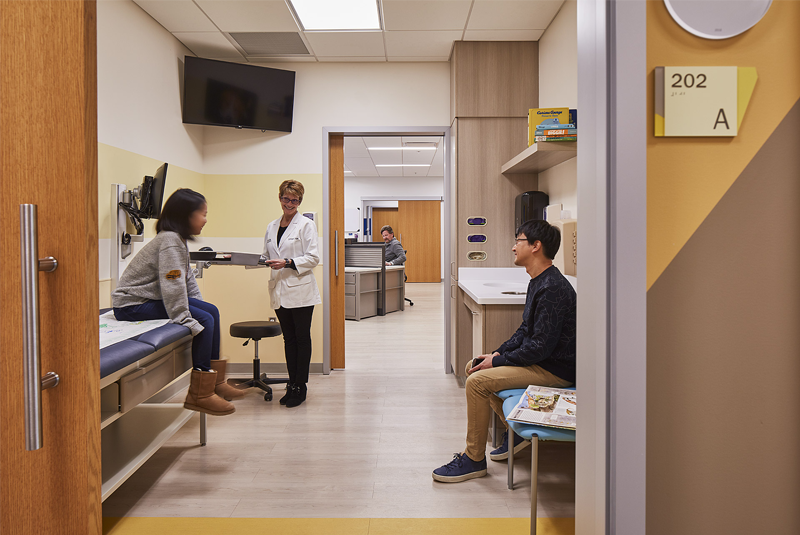
In addition to local code and healthcare specific requirements or best practices, many local Authority Having Jurisdictions (AHJ) also have specific and varying interpretations of these codes, especially as they impact complex or new products, so specifiers are encouraged to get clear approvals during the planning and review stages when possible.
While knowing the code requirements for hospital rooms doors is critical, it is only one part of the design equation. Flexibility, efficiency and durability can also be important aspects to consider when choosing doors for acute care, patient rooms and other areas within a healthcare environment. This Q+A with Tysen Gannon, LEED AP (BD+C), will explain what considerations can help architects design better healthcare environments and how wide opening doors provide tangible benefits over a healthcare center’s lifetime.
Q. How does room use influence door design choices?
A. When working with healthcare facilities, it is critically important to understand the purpose of the space. This sounds, of course, very obvious, but healthcare is ever-changing and evolving, so the needs of a room and its door opening may change on a regular basis as well as over time.
What types of patients will be cared for in this space? Will there ever be a need to accommodate a movable bed or bariatric wheelchair? What about technology, will mobile workstations or medical equipment be moving in and out? In a pandemic or surge scenario, will the room’s use need to be flexible? Is it likely multiple specialties might use this space and how might their needs differ?
Being aware of the answers to these questions and others like them can help designers choose hospital room doors that balance multiple needs. Based on the types of patients, equipment and possible future changes to how these patients are cared for, it is essential to choose a door that meets or exceeds the functional needs of the space and does not hinder the delivery of quality care.
Q. How can sliding doors work with the constraints of healthcare settings?
A. Often, sliding doors are purposefully built with the needs of medical centers in mind. They can provide a wide range of benefits in healthcare settings. First and foremost, they can save valuable space by eliminating a door’s swing arc and reducing approach clearances. For clinics, this can mean: more exam rooms, better space utilization for storage, seating and workstations. It can also translate to increased room in the building for maneuvering and accommodating more patients.
With durable and low-maintenance hardware, sliding doors can be an easy-to-use and easy-to-sanitize option. Further, glazing options and perimeter seals can help this sliding door meet a variety of visual and acoustic privacy needs. Sliding doors can even potentially meet more advanced requirements such as mitigating air infiltration, offering smoke and fire ratings as well as being compatible to access control systems.
Q. Where can large opening doors be used in healthcare facilities?
A. Large opening doors are required throughout healthcare projects—the more obvious locations include: entry doors, entrances to operating rooms and corridors in inpatient facilities. Likewise, large entry doors are often needed for ICU and CCU patient rooms, lower acuity patient rooms, patient toilet rooms, procedure rooms, laundry and utility rooms.
For outpatient care, it is important that at least some exam rooms are able to accommodate bariatric wheelchairs or other assistive devices. Utility rooms in outpatient areas also benefit from larger door openings as do high traffic areas such as playrooms, enclosed waiting areas or places like physical therapy rooms.
Q. What door customizations are available for healthcare settings?
A. Healthcare has a broad range of highly specific needs. One of the most common is electronic access control for high levels of physical security to medication rooms or treatment spaces.
Increasingly, isolation rooms and other areas, such as NICU, pharmacy or lab spaces, require doors that control air infiltration. Thus, their doors may need to seal tightly (or the opposite to allow for HVAC evacuation). Further, doors that allow for flexibility, like DualSwing—a variation on a typical swing door, provide a larger door opening when needed. And sliding doors that can allow for the passage of bed lifts are also an important customization for care providers to accommodate a variety of patient needs.
Other types of customization include: lead shielding for imaging rooms, anti-microbial coatings for infection control, specialty laminates or integral blinds, louvers and even switchable glazing for areas where there are alternating demands for visual communication and privacy.
This is all in addition to the typical needs for customization of hardware configurations, sizes and finishes seen throughout most healthcare projects.
Hospital room doors that go beyond code compliance
Sliding and other wide opening options can help designers specify doors for hospital patient rooms and other areas throughout a healthcare environment that meet or exceed code requirements and provide the flexibility needed for a facility that can quickly adapt to changes in patient needs or healthcare technology. As such, they can deliver a significant value to project owners and architects alike.







